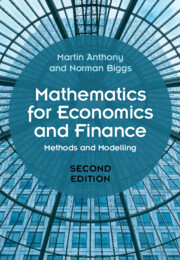Refine search
Actions for selected content:
6971 results in Mathematical modeling and methods
14 - Vectors, Preferences and Convexity
-
- Book:
- Mathematics for Economics and Finance
- Published online:
- 24 May 2024
- Print publication:
- 30 May 2024, pp 137-151
-
- Chapter
- Export citation
Appendices
-
- Book:
- Mathematics for Economics and Finance
- Published online:
- 24 May 2024
- Print publication:
- 30 May 2024, pp 361-415
-
- Chapter
- Export citation
27 - First-Order Differential Equations
-
- Book:
- Mathematics for Economics and Finance
- Published online:
- 24 May 2024
- Print publication:
- 30 May 2024, pp 301-318
-
- Chapter
- Export citation
Appendix B - Answers to Problems
-
- Book:
- Mathematics for Economics and Finance
- Published online:
- 24 May 2024
- Print publication:
- 30 May 2024, pp 408-415
-
- Chapter
- Export citation
29 - Coupled Systems and Diagonalisation
-
- Book:
- Mathematics for Economics and Finance
- Published online:
- 24 May 2024
- Print publication:
- 30 May 2024, pp 334-346
-
- Chapter
- Export citation

Mathematics for Economics and Finance
- Methods and Modelling
-
- Published online:
- 24 May 2024
- Print publication:
- 30 May 2024
-
- Textbook
- Export citation
ELECTRO-OSMOTIC EFFECT ON PERISTALTIC FLOW OF PHAN–THIEN–TANNER FLUID IN A PLANAR CHANNEL
- Part of
-
- Journal:
- The ANZIAM Journal / Volume 66 / Issue 1 / January 2024
- Published online by Cambridge University Press:
- 24 May 2024, pp. 77-97
-
- Article
- Export citation
INDEX
-
- Journal:
- The ANZIAM Journal / Volume 65 / Issue 4 / October 2023
- Published online by Cambridge University Press:
- 10 May 2024, pp. 411-412
-
- Article
- Export citation
ANZ VOLUME 65 ISSUE 4 COVER AND FRONT MATTER
-
- Journal:
- The ANZIAM Journal / Volume 65 / Issue 4 / October 2023
- Published online by Cambridge University Press:
- 10 May 2024, pp. f1-f2
-
- Article
-
- You have access
- Export citation
ANZ VOLUME 65 ISSUE 4 COVER AND BACK MATTER
-
- Journal:
- The ANZIAM Journal / Volume 65 / Issue 4 / October 2023
- Published online by Cambridge University Press:
- 10 May 2024, pp. b1-b4
-
- Article
-
- You have access
- Export citation
EXPONENTIAL ASYMPTOTICS USING NUMERICAL RATIONAL APPROXIMATION IN LINEAR DIFFERENTIAL EQUATIONS
- Part of
-
- Journal:
- The ANZIAM Journal / Volume 65 / Issue 4 / October 2023
- Published online by Cambridge University Press:
- 22 April 2024, pp. 285-307
-
- Article
-
- You have access
- Open access
- HTML
- Export citation
FLUID INJECTION IN A POROUS MEDIUM: THE RADIAL SAFFMAN–TAYLOR INSTABILITY
- Part of
-
- Journal:
- The ANZIAM Journal / Volume 65 / Issue 4 / October 2023
- Published online by Cambridge University Press:
- 19 April 2024, pp. 347-383
-
- Article
-
- You have access
- Open access
- HTML
- Export citation
DETECTING MOISTURE IN BAUXITE USING MICROWAVES
- Part of
-
- Journal:
- The ANZIAM Journal / Volume 65 / Issue 4 / October 2023
- Published online by Cambridge University Press:
- 17 April 2024, pp. 308-346
-
- Article
-
- You have access
- Open access
- HTML
- Export citation
OPTIMAL QUEUING STRATEGIES FOR AN M/G/1 RETRIAL QUEUE SYSTEM WITH RWV AND ISEV POLICIES
- Part of
-
- Journal:
- The ANZIAM Journal / Volume 65 / Issue 4 / October 2023
- Published online by Cambridge University Press:
- 19 March 2024, pp. 384-410
-
- Article
- Export citation
ANZ VOLUME 65 ISSUE 3 COVER AND FRONT MATTER
-
- Journal:
- The ANZIAM Journal / Volume 65 / Issue 3 / July 2023
- Published online by Cambridge University Press:
- 12 March 2024, pp. f1-f2
-
- Article
-
- You have access
- Export citation
ANZ VOLUME 65 ISSUE 3 COVER AND BACK MATTER
-
- Journal:
- The ANZIAM Journal / Volume 65 / Issue 3 / July 2023
- Published online by Cambridge University Press:
- 12 March 2024, pp. b1-b6
-
- Article
-
- You have access
- Export citation
ACTIVE REMODELLING OF TISSUES TO DESCRIBE BIPHASIC RHEOLOGICAL RESPONSES
-
- Journal:
- The ANZIAM Journal / Volume 65 / Issue 3 / July 2023
- Published online by Cambridge University Press:
- 26 February 2024, pp. 195-214
-
- Article
-
- You have access
- Open access
- HTML
- Export citation
APPROXIMATE PRICING OF DERIVATIVES UNDER FRACTIONAL STOCHASTIC VOLATILITY MODEL
- Part of
-
- Journal:
- The ANZIAM Journal / Volume 65 / Issue 3 / July 2023
- Published online by Cambridge University Press:
- 15 January 2024, pp. 229-247
-
- Article
- Export citation
NONLINEAR SELF-MODULATION OF GRAVITY-CAPILLARY WAVES ON SHEAR CURRENTS IN FINITE DEPTH
- Part of
-
- Journal:
- The ANZIAM Journal / Volume 65 / Issue 3 / July 2023
- Published online by Cambridge University Press:
- 12 January 2024, pp. 248-272
-
- Article
- Export citation
ON MODELLING WATER QUALITY WITH STOCHASTIC DIFFERENTIAL EQUATIONS
- Part of
-
- Journal:
- The ANZIAM Journal / Volume 65 / Issue 3 / July 2023
- Published online by Cambridge University Press:
- 09 January 2024, pp. 273-284
-
- Article
- Export citation


